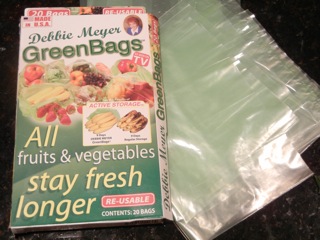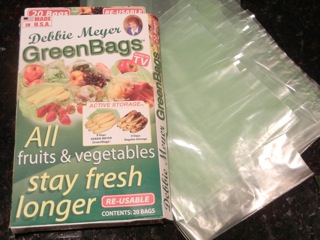Have you ever purchased fresh produce only to discover that it has rotted a few days later? If so, you know how aggravating this experience can be. Infomercials claim to have the solution: Green Bags. According to Evert Fresh, their Green Bags can extend the life of your produce by 3 to 10 times. But does this “as seen on TV” product really work?
days later? If so, you know how aggravating this experience can be. Infomercials claim to have the solution: Green Bags. According to Evert Fresh, their Green Bags can extend the life of your produce by 3 to 10 times. But does this “as seen on TV” product really work?
In the 1990’s, scientists looking for a way to prolong the lifespan of produce in preparation for a trip to Antarctica discovered an area in Japan that for thousands of years had been successfully housing and storing produce in mountain caves. The mountains were composed of clay called oya, which contains zeolite, a naturally occurring desiccant.
The Michigan Science Teachers Association (MSTA) Journal of Fall 2010 states that green bags combine this ancient Japanese knowledge on how to keep produce fresh using oya with modern technology.
The zeolite in oya is a mineral that naturally absorbs oxygen. In addition, according to the March 25, 1989 edition of New Scientist, zeolite is able to absorb ethylene gas. Ethylene gas (C2H4) is a compound released by most produce that increases the natural rate of ripening.
Naturally occurring zeolite is found in volcanogenic sedimentary rocks. According to the Mineral Information Institute, there are about 50 naturally occurring zeolites, each with a framework structure composed of large open cavities filled with cations and water. The porous structure of zeolite can accommodate a wide variety of cations, such as Na+, K+, Ca2+, and Mg2+. Because of these large cavities, the water and ions within the framework are able to move about easily. Zeolites are also noted for their ability to lose and regain water over and over again, a process also known as reversible dehydration. These properties allow zeolites to be used every day in things like laundry detergent, cat litter, and water purification.
The April, 1999, publication of ChemMatters says that pellets of zeolite are used by various produce companies to remove ethylene from the atmosphere of produce when they are being transported. This zeolite, which is also used in Green Bags, is saturated with potassium permanganate (KMnO4), a good oxidizing agent. (An oxidizing agent is a compound that acts as an acceptor of electrons.) Potassium permanganate works as an oxidizer of ethylene gas.
According to the MSTA Journal, every fruit gives off a different amount of ethylene and is affected by ethylene differently. Catalytic Generators LLC, a company that produces ethylene application systems that ripen fruit, says “ethylene producing items (such as apples, bananas, melons, peaches, pears, and tomatoes) should be stored separately from ethylene-sensitive ones (broccoli, cabbage, cauliflower, leafy greens, lettuce, etc.).”
Whether or not green bags work is often quite controversial. The Homemade Baby Food Recipes Blog sent out a survey regarding Green Bags and discovered that 65% of its readers said they work as advertised, 20% were disappointed, and 15% found they worked but still had some reservations.
Do green bags work? KFVS Heartland News in southeastern Missouri tested green bags in 2008 and came to the conclusion that they do not effectively keep produce fresher. For the experiment one banana was left out on the counter and one was placed in a green bag. They returned 30 days later to find that both bananas were equally brown and spoiled. The green bag company claimed that the bags “work better on produce picked right off the vine.” The experiment conducted by KFVS used store bought fruit that had been shipped from elsewhere.
On the other hand, there are many people who testify to the effectiveness of this “as seen on TV” product. A local mother and avid Green Bag user, Karen Tennant, says “I’ve been using the bags for over a year and absolutely know they make a difference.” In addition, Michelle Haas, a long-time Green Bag user, vows “Green Bags work and they save me money. My produce lasts much longer. I have been so pleased with the results that I have even given all my friends a package of Green Bags as a gift.”

This work is licensed under a Creative Commons Attribution-NonCommercial-NoDerivs 3.0 Unported License















Great article! I didn’t even know that Green Bags existed, but now I do! Maybe I should buy them and test them out. They sound very interesting.
Very interesting topic. This can help many families when grocery shopping to preserve fruits and vegetables for much later. I like the face that you mentioned that it will save money as well as save the perishable foods.
That’s interesting, I never knew that fruits’ ripening was all because of a gas!
Why does it make a difference if the fruit put in the green bags comes picked straight from the vine or is delivered from somewhere else?
Very creative, informative, and interesting topic; great article!
Anna, I really liked this article. I thought it was very thought provoking and it exposed me to material I had not know previously. I am curious though, do you have any personal experience with Green Bags or was this something that you were just interested in and if you have had experience with them do you think they really work?
Anna,
I really enjoyed reading this especially because you took something that is not very interesting and made the article interesting which seems hard to do. after reading this i actually learned a lot about green bags that i never knew before. i always knew they existed but i have never used them before and i have never even thought about using them before. But now that i see how they work i think i might buy some for myself.
Great job on the Article,
Victoria H.
I enjoyed this article because it gave good information. Now I understand why Green Bags are different from the everyday Ziploc bags.
Interesting topic and good insights
I really enjoyed this article. Very well written. I liked how you emphasized the fact that it wouldn’t only save the perishable foods, but the green bag would also save you money.
good article! 🙂
this is really good! It was a really good read!
very detailed article
very good job. it was very interesting.
I thought this article was very interesting. It had some very good facts, and it was a good topic.I have wondered about green bags for a long time. Great job!
great article! always wanted to learn more about this topic!:smile
Anna,
Good article, I just have a couple of comments. Zeolite by it self does very little to remove ethylene gas. Where zeolite impregnated with potassium permaganate is very effective at removing ethylene gas and also kills molds, rots and bacteria. Some zeolites have heavy metal and other thigs that can create a disposial problem. A company called Ethylene Control in California uses a pure zeolite with 5% potassium permaganate ate was tested in the mid 90’s by U C Davis along side the Green Bag. The Ethylene Control pellets were a lot more effective at removing ethylene.
Dave
they do work:flag
Good Research and Nice Post.
The part that gets me is the statement using store bought instead of fresh picked most of the users would be uaing store bought. Honestly I don’t bother with the bags. If my produce starts to look like i have 2-3 days left i pull out my dehydrator for veggies and my jam making stuff for fruit. That seems to work great